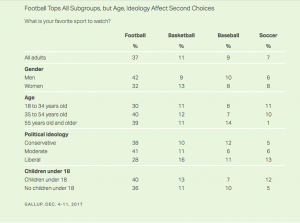American football, under attack from critics in recent years, has lost some of its popularity but is still the champion of U.S. spectator sports — picked by 37 percent of U.S. adults as their favorite sport to watch, according to a Gallup poll. The next-most-popular sports are basketball, favored by 11 percent, and baseball, favored by 9 percent.
The 9 percent of Americans who mention baseball as their favorite sport to watch is the lowest percentage for the sport since Gallup first asked the question in 1937. Americans named baseball as the most popular sport in 1948 and 1960, but football claimed the top spot in 1972 and has been the public’s favorite ever since.
Soccer now nearly matches baseball’s popularity. Seven percent say it is their favorite sport to watch, the highest that sport has registered to date. Only once before have at least 7 percent of Americans named a sport other than football, basketball or baseball as their favorite — and that was auto racing in 1997. (Auto racing is now down to 2 percent of mentions.)
Though football retains its top spot, its popularity has slipped since peaking at 43 percent in 2006 and 2007. In 2008, it dipped slightly to 41 percent and dropped again to 39 percent in 2013 — the last time the question was asked before the December 2017 poll and its 37 percent reading.
Among the possible reasons for the drop in recent years:
- In 2014, a video of National Football League star running back Ray Rice punching his wife and dragging her unconscious body from an elevator shocked the nation. It pushed the already-simmering issue of NFL players’ domestic assaults into national prominence, sparking protests and calls for NFL Commissioner Roger Goodell to resign.
- Numerous studies dating back to the 1990s had documented the physical and mental toll concussions were taking on football players at all levels. One of the studies inspired the movie Concussion, released nationwide in 2015.
- Protests by NFL players during the pregame playing of the U.S. national anthem in 2016 and 2017 drew strong criticism from President Donald Trump and conservative pundits.
With the national-anthem controversy in full swing this past October, a Gallup poll indicated the NFL was taking a hit.
Fifty-seven percent of Americans said they were fans of professional football, down 10 percentage points from the previous time the question was asked, in December 2012. Support for most other sports, including college football, had not changed meaningfully during the same five-year span.
Football Leads Among All Groups, but Some Like It Less Than Others
Women were less likely than men to pick football as their favorite sport even before the issue of players’ assaults on women exploded in 2014, and that still holds true. Conservatives, in spite of the national-anthem protests the last two years, are only slightly less likely than moderates to favor football, and are more likely to do so than liberals. Parents of children under 18, who might be expected to be most affected by the publicity surrounding concussion risks football players face, are about as likely as others to pick football as their favorite.
Meanwhile, those who determine the future of spectator sports — 18- to 34-year-olds — are the age group least likely to favor football. But even among them, football tops all other sports by a comfortable margin. Soccer and baseball show meaningful differences by age, with soccer appealing more to adults younger than 55 and baseball more to adults aged 55 and older.
For the past half-century, football has been America’s game, unrivaled by any other spectator sport. Even the challenges it currently faces have had only a small effect on Americans’ likelihood to consider it their favorite spectator sport. Though Gallup’s October polling showed a decline in the percentage of Americans saying they are fans of professional football, the drop-off did not occur among college football fans, and it may not have included the hardcore NFL fans who consider it their favorite sport.
But the fact that the sport has weathered the attacks on it so far is no guarantee that it will do so over the long run. Football’s relatively low popularity among younger Americans, combined with ever-growing evidence of the physical and mental damage the sport does even at the high school level, could jeopardize its standing in the decades ahead.
And for all spectator sports in the U.S., there is one other sobering statistic to consider. The number of Americans who say they do not have a favorite sport has grown from 8 percent in 2000 to 15 percent now — an increase larger than for any sport during that time.
Photo courtesy Lids

















